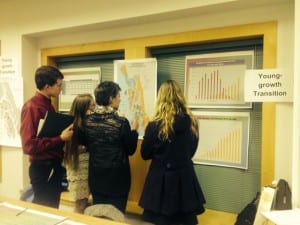
Y.A.C. members Ella Sherril, Sage Acteson and Cheyenne Matthews look over maps at the Tongass National Forest open house in Ketchikan on Monday February 2, 2015.
The Tongass National Forest held three informational open houses in Southeast about it’s upcoming forest plan amendment. The meetings were in Juneau, Sitka and wrapped up earlier this week in Ketchikan- where there was a group of well-dressed high schoolers .
The Tongass National Forest’s Land and Resource Management Plan governs everything done on the Tongass and officials are working to amend the plan by August 2016. The recent open houses are a part of the process.
Project manager for the plan amendment, Susan Howle , laid out how the open house would work. “ What we did was we’ve set up the room by stations and our stations are kind of focused on what are issues are for analysis.” The amendment addresses four issues. Howle points around the room to each of the stations: Foldout tables with maps, graphs and Forest Service employees to answer questions . “Young growth transition, renewable energy, roadless areas and then over here we have wildlife habitat and the conservation strategy.”
The transition away from harvesting old-growth timber is the biggest issue, and it’s why the Tongass is amending it’s plan in the first place. A memo from the Department of Agriculture pushed for a vast majority of the Tongass timber sales to be young growth within the next 10-15 years. The current forest plan calls for reaching that mark by around 2040.
But changing the forest plan doesn’t mean just changing the numbers. There’s a rule book. The rule book used for the current forest plan was written in 1982. But a new rule book came out in 2012, and that is the one they need to follow for the amendment they’re working on. The Tongass is the first national forest using the 2012 planning rule to make an amendment. Howle opened the book and read “ A…one…ii, in providing opportunities for engagement the responsible official shall encourage participation by… interested individuals and entities including those interested at the local, regional, and national levels. And then two, youth, low income populations and minority populations.”Howle said the Forest Service has always tried to reach out to the public, “ interested parties, but I don’t think it’s ever been that specific before, where they talked about youth.”
A group of three teenagers is standing in front of a map at the young growth station. They  are part of the new Youth Advisory Council. “What do the different grey areas mean?” Silviculturist, Sheila Spores explains to Ella Sherrill that the grey represents private land, that black on the map was recently acquired by Sealaska and that other areas blacked out are for conservation. All of those places where, even if there was young growth, it couldn’t be harvested. Cheyenne Matthews wonders about what remains on the map. “ Are there companies that are willing to come into these little harvest areas and actually harvest the timber? Well that’s the million dollar question.”
are part of the new Youth Advisory Council. “What do the different grey areas mean?” Silviculturist, Sheila Spores explains to Ella Sherrill that the grey represents private land, that black on the map was recently acquired by Sealaska and that other areas blacked out are for conservation. All of those places where, even if there was young growth, it couldn’t be harvested. Cheyenne Matthews wonders about what remains on the map. “ Are there companies that are willing to come into these little harvest areas and actually harvest the timber? Well that’s the million dollar question.”
Tongass officials trying out one of new rule book’s specifications, reached out to a Kayhi guidance council who assembled eight students for the Youth Advisory Council. Seven came to the open house. Cheyenne Matthews is interested in studying political science in college, and said she appreciates the introduction to bureaucracy. “ You know you don’t really think about the forest you just live in it, you appreciate it, but then once you become part of the committee you realize that there are issues out there it’s not just a pretty forest there’s economic and ecological issues you have to think about you can’t just enjoy the view.”
Ultimately the YAC’s goal is to comment publicly on the amendment. The public comment period opens at the end of July. Forest Planner, Sue Jennings saids the open house was a way to inform members of the public before they submit comments. “I’m hoping more than just the youth comment. I hope everyone comments in July.” Jennings said the forest plan is always better when people say what they want.





